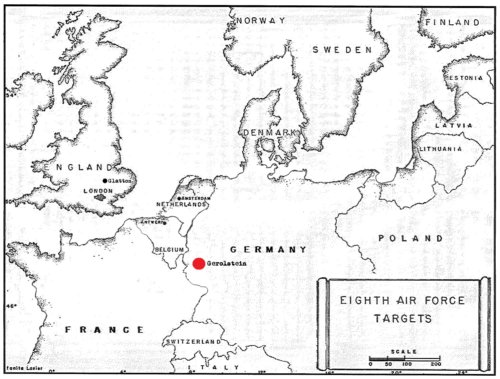TARGET: RAILROAD BRIDGE
GEROLSTEN, GERMANY
27 DECEMBER, 1944
In spite of unfavorable flying conditions, the 457th was back in action, planes and crews having returned to Base from Eye on December 26.
Major Snow led the Group of 36 planes flying as the 94th B Combat Wing. The target was a railroad bridge at Gerolstein. It was part of the Allied plan to disrupt and destroy the enemy’s lines of communications and the flow of supplies to the battle area.
The target was near the Belgian border and was on the main rail line carrying traffic into Belgium to support the Germans’ Ardennes Offensive.
The route over England was flown on time, on course and at proper altitude until the vicinity of March when it became necessary to deviate approximately five miles north of course, in order to get into Combat Wing formation. Division assembly line was flown in trail of the 94th A Wing. The entire Wing was able to get back on course before reaching the second Control Point. Course to the target was flown approximately as briefed, except for minor deviations in order to remain in Division formation. The Group was about one minute early in arriving at the IP because of winds.
The Group came across the IP on course. The general target area was visual and a visual run was ordered with G-H assistance. Bombing was done by squadrons, in trail, but not in proper bombing order. The high squadron, not having heard the signal for a visual run, had prepared to bomb in Group formation and had pulled up close to the lead squadron. As the Group proceeded down the bomb run, the high squadron was not able to get behind the low squadron and proceeded down the run in trail of the lead. The lead and low squadrons attacked the primary target area visually, with G-H assistance. The high squadmn was not able to pick up the target on the run, executed a 360 degree turn in order to make a second run and bombed in the smoke. There were no clouds, and visibility was good in the air. The visibility on the ground was poor, particularly in the target area, which was in a valley. The only difficulty encountered was experienced by the low squadron, which hit violent prop wash immediately prior to bombs away. The bombs were dropped from 22,750 feet. Bombing results were good.
After bombing, the lead and low squadrons, having rallied, made a wide turn off of the target to the left of the briefed course in an attempt to allow the high squadron to rejoin the Group. The high squadron was about four minutes behind the lead squadron, was never able to rally, and proceeded to base individually.
Lt. Edwin B. Benson, 457th/749th bombardier: Mission 21. Gerolstein. R.R. yards. Time 7.35. Low. Lead. FLAK
